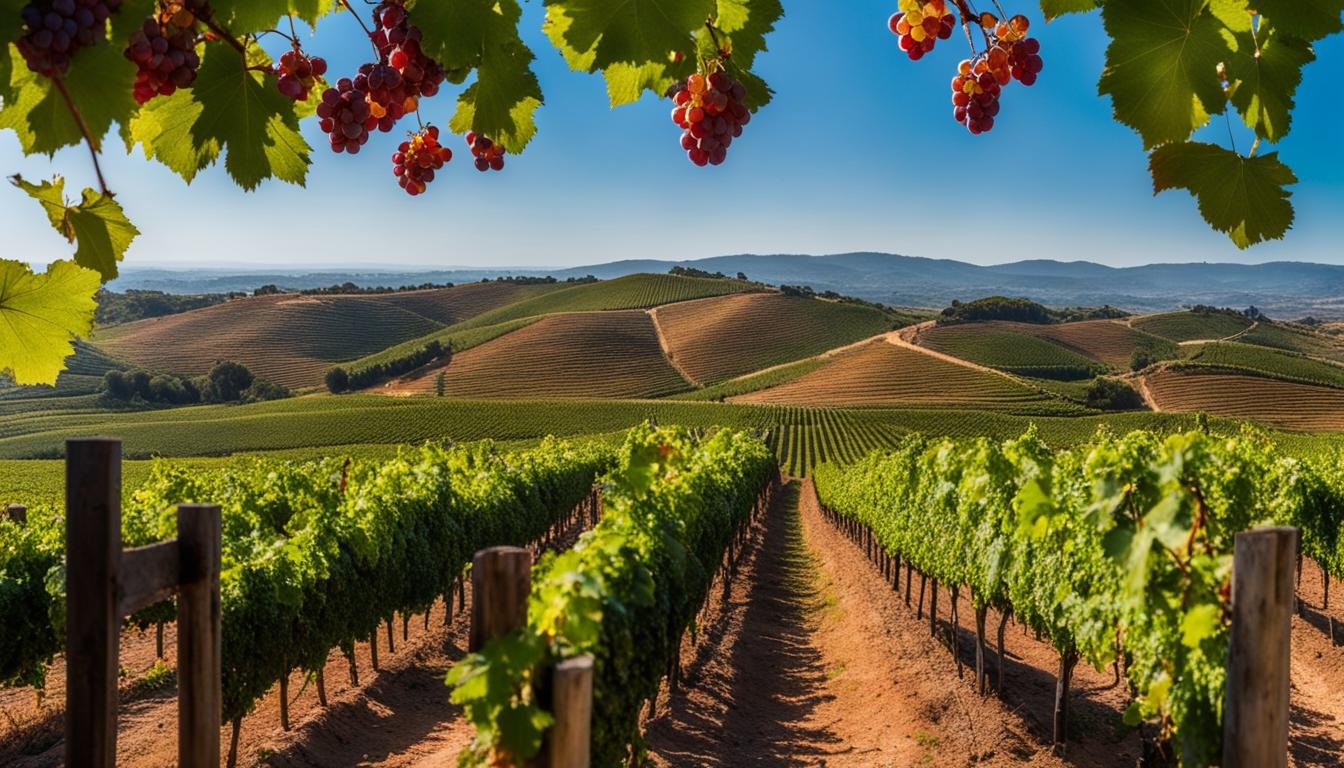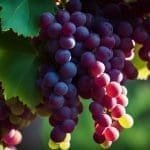This post may contain affiliate links. Please read my disclosure policy.
Baga: The Rustic Charmer of Portuguese Vineyards
Baga, pronounced “Bah-gah,” is like the spirited artisan of the Portuguese wine world. Known for its bold character and ability to produce deeply coloured, tannic wines, Baga is a grape that tells a story of tradition and terroir. Let’s explore the world of Baga – a wine that embodies the rustic charm and rich heritage of Portugal’s vineyards.
Primary Flavours
Tasting Baga is like embarking on a sensory journey through the heart of Portugal. It offers a bouquet of red and dark fruits, notably cherries and blackberries, intermingled with earthy undertones and a hint of spice. There’s a raw authenticity to it, a reflection of its robust and unyielding nature.
Taste Profile
| Baga | Baga | Baga |
|---|---|---|
| Aspect | Rating out of 5 | Characteristic |
| Sweetness | 🍷 | Predominantly dry, with a subtle whisper of dark fruits |
| Body | 🍷🍷🍷🍷 | Full-bodied, as rich as a tapestry in a Lisbon mansion |
| Tannins | 🍷🍷🍷🍷🍷 | Robust and commanding, like a fado singer's presence |
| Acidity | 🍷🍷🍷🍷 | Strikingly high, akin to the lively rhythm of a Portuguese dance |
| Alcohol by Volume | 🍷🍷🍷🍷 | Typically around 12-14%, as heartwarming as a sunset in Porto |
| Each wine glass icon 🍷 represents one point on a 5-point scale. Baga is noted for its high tannins and acidity, which contribute to its notable structure and longevity. This grape variety often yields wines that are complex and become more refined with age, showcasing flavours of red berries, earth, and spice. | Each wine glass icon 🍷 represents one point on a 5-point scale. Baga is noted for its high tannins and acidity, which contribute to its notable structure and longevity. This grape variety often yields wines that are complex and become more refined with age, showcasing flavours of red berries, earth, and spice. | Each wine glass icon 🍷 represents one point on a 5-point scale. Baga is noted for its high tannins and acidity, which contribute to its notable structure and longevity. This grape variety often yields wines that are complex and become more refined with age, showcasing flavours of red berries, earth, and spice. |
Growing Regions
Baga is primarily grown in the Bairrada region of Portugal, where it has long been the dominant grape variety. The cool, damp climate of Bairrada is ideal for this grape, allowing it to develop its distinctive profile. This grape is also cultivated in other Portuguese regions, but it’s in Bairrada where it truly shines.
Origin and Winemaking Tradition
With deep roots in Portuguese winemaking history, Baga is a grape variety that has been cherished for generations. Traditionally used to create powerful and age-worthy wines, it has recently undergone a renaissance, with winemakers experimenting to bring out its more approachable and fruit-forward side. The evolution of Baga is a testament to the versatility and resilience of this historic varietal.
Serving Temperature
The ideal serving temperature is about 16-18°C (60-65°F). This range allows the wine’s robust character to shine without overpowering its nuanced flavours. Too cold, and you mute its complexity; too warm, and you’re in for a tannic overload.
This wine loves to show off in a large, bowl-shaped glass. This type of glass allows ample room for the wine to breathe, softening those bold tannins and letting the intricate flavours of fruit and spice pirouette gracefully on your palate.
Decanting
Decanting is a must for most Baga wines, especially the younger, tannin-heavy ones. Giving it some time to breathe softens its robust edges and allows the subtler flavours to emerge, making for a smoother, more enjoyable sip.
Ageing
Baga is like a fine actor, getting better with age. With time, its tannins mellow, and the wine develops a more complex character, revealing layers of flavour that include dried fruits, nuts, and spices. Some well-aged Baga wines can be a revelation, offering a tapestry of tastes that tell the story of its evolution.
Food Pairings
The vibrant acidity and substantial tannins of this Portuguese star make it a perfect companion for a wide array of culinary delights. Let’s explore some expanded food pairing ideas that will complement its unique character.
Traditional Portuguese Cuisine:
- Cozido à Portuguesa: This rich, multi-layered stew, brimming with meats and vegetables, harmonizes wonderfully with the wine’s boldness.
- Bacalhau à Brás: The salty complexity of this cod dish is beautifully balanced by the high acidity and fruity undertones of the wine.
International Flavours:
- Barbecue Brisket: The deep, smoky flavors of brisket find a perfect match in the tannic structure and fruitiness of the wine.
- Spaghetti Bolognese: A classic meaty tomato sauce pairs splendidly with the wine’s earthy notes and vibrant acidity.
Cheese Companions:
- Azeitão Cheese: This creamy Portuguese sheep’s milk cheese contrasts nicely with the wine’s tannic profile.
- Manchego: The firm texture and nuttiness of Manchego create a delightful pairing with the wine’s fruit-forward nature.
Vegetarian Delights:
- Grilled Portobello Mushrooms: Their earthy flavor complements the wine’s rustic and fruity notes.
- Eggplant Parmesan: The dish’s richness and tomato sauce work well with the wine’s robustness and acidity.
Bold and Spicy Options:
- Chorizo and Bean Stew: The spicy chorizo is offset by the fruity and tannic nature of the wine, creating a balanced experience.
- Jerk Chicken: The spices and heat in jerk seasoning are tamed by the wine’s robust and fruity character.
Sweet and Savoury Fusion:
- Roast Pork with Apples: The sweetness of apples and savory pork offer a delightful contrast with the wine’s bold nature.
- Moroccan Lamb Tagine: The sweet and savory elements in the tagine pair exquisitely with the wine’s complexity.
These pairings highlight the versatility of this robust Portuguese grape, showing its ability to complement a wide range of flavors from traditional Portuguese dishes to international cuisine. Whether enjoying a simple meal or an elaborate feast, there’s a pairing that can enhance the culinary experience.
Wine Labels
Exploring different expressions of Baga through various labels offers a glimpse into its versatility. Below is a table showcasing some popular brands, highlighting the diversity of this distinctive grape:
| Baga | ||
|---|---|---|
| Country | Wine Label | Varietal Name & Style |
| Portugal | Luis Pato | Bairrada Baga - Dry, Full-bodied |
| Portugal | Quinta das Bágeiras | Bairrada Baga - Dry, Traditional |
| Portugal | Filipa Pato | Bairrada Baga - Dry, Modern |
| Portugal | Sidónio de Sousa | Bairrada Baga - Dry, Aged |
| Portugal | Niepoort | Bairrada Baga - Dry, Elegant |
| Note: These brands are known for their quality and representation of the Baga grape, ranging from traditional, age-worthy wines to more modern, approachable styles. | Note: These brands are known for their quality and representation of the Baga grape, ranging from traditional, age-worthy wines to more modern, approachable styles. | Note: These brands are known for their quality and representation of the Baga grape, ranging from traditional, age-worthy wines to more modern, approachable styles. |
Conclusion
Baga is more than just a wine; it’s a journey into the heart of Portuguese winemaking. It’s about embracing the bold, the rustic, and the authentic. So, when you next have the opportunity to enjoy a glass of Baga, immerse yourself in its rich flavours and storied past. It’s the grape that brings the essence of Portugal’s vineyards to life, one sip at a time.
Is Baga a red or white wine?
Baga is a red wine grape, used predominantly to craft red wines known for their acidity and tannic structure.
To which wines is Baga similar?
Baga is similar to Nebbiolo and Pinot Noir, offering a balance of high acidity and tannins, along with complex flavours that develop with age. These wines share a capacity for ageing and evolving flavour profiles.
What are some interesting facts about Baga?
• Baga is a red grape variety native to Portugal, specifically the Bairrada region.
• Known for producing high-acid, tannic wines with great ageing potential.
• Often creates wines with flavours of red berries, black plums, and earthy notes.
• Baga wines can range from light-bodied and fresh to robust and complex.
Which country produces the most Baga?
Portugal is the primary producer of Baga, with the Bairrada region being the grape’s main growing area. Baga is a cornerstone of Bairrada’s winemaking tradition.
User Review
( votes)Sip smarter, subscribe now!
Subscribe for gourmet tips, event updates, travel ideas, and a free e-book on Food Pairings. Start your journey to culinary and travel excellence!













